Robotaxi & Cybercab Face More Pre-Launch Troubles
Discover the hurdles facing Robotaxi & Cybercab as they prepare for a launch.
Eddie
May 9, 2025

As Tesla gears up to introduce its self-driving ride services with innovative terms like "Robotaxi" and "Cybercab," the road to launch presents several challenges. Recent decisions from the U.S. Patent and Trademark Office (USPTO) have not been in Tesla's favor, rendering "Robotaxi" too generic to trademark. Meanwhile, fierce competition in the autonomous vehicle market and questionable design choices have placed Elon Musk's ambitious plans under scrutiny. Compounding these obstacles is an internal analysis predicting financial losses.
Challenges Facing Tesla's Robotaxi and Cybercab Launch

Tesla, the leading electric vehicle manufacturer, is facing significant hurdles in its ambition to launch the Robotaxi and Cybercab services. These challenges range from legal predicaments to doubts over safety designs and financial concerns.
Trademark Issues with the USPTO
One of the first issues Tesla faces is with the U.S. Patent and Trademark Office (USPTO), which has complicated the launch of its self-driving ride services. Tesla's requests to trademark the terms "Robotaxi" and "Cybercab" have hit roadblocks. The USPTO labeled the term "Robotaxi" as "too generic," considering it merely descriptive of the category of services, therefore unfit to be claimed as a trademark by Tesla or any single entity. This decision leaves Tesla in a bind, as the company has three months to contest this assessment or risk having the application abandoned. Moreover, the "Cybercab" application has also been paused due to conflicts with other competing trademark claims involving the use of "Cyber," complicating Tesla's branding efforts substantially.
Skepticism Regarding Safety and Design
Skepticism is mounting regarding the safety and design of Tesla’s autonomous vehicles. Industry experts, including John Krafcik, former CEO of Waymo, have raised concerns about the practicality and safety of Tesla's proposed models. Ideal robotaxi designs prioritize safety with externally mounted sensors and easy passenger access, yet Tesla's concept features a small, low-slung vehicle, unsuitable for efficient ingress and egress. The prototype that Tesla introduced—a two-seater with limited functionality—does not align with industry standards of autonomous vehicle design, raising concerns about its viability in a market where passenger comfort and safety are paramount.
Internal Analysis Suggesting Financial Losses
Internally, Tesla is grappling with economic predictions that forecast bleak financial returns from its Robotaxi initiative. Projection reports within Tesla have illustrated that the planned self-driving service could accumulate losses, casting doubt on its success. Analysts pointed out that the model relied heavily on assumptions of massive fleet sales and widespread consumer adoption. Moreover, faced with the hurdles of regulatory challenges and market readiness, these predictions seemed optimistic at best. Despite this, Elon Musk chose to focus efforts on the robotaxi concept, even after internal recommendations suggested prioritization of other vehicle programs, such as the development of a $25,000 Tesla model.
Competitive Landscape and Market Dynamics

While Tesla contends with internal and technical barriers, external pressures from the competitive landscape and shifting market dynamics pose additional challenges.
Intense Competition from Established Players
Tesla's journey to autonomous dominance is threatened by stiff competition from established players in the sector, such as Waymo and Uber, who have leveraged substantial experience and infrastructure to grow their market presence successfully. With established operations in key demographics, including Austin, Texas, Waymo showcases that achieving a functional and accepted driverless service is possible. This existing competitive edge makes it critical for Tesla to navigate both consumer and system integration hurdles deftly.
Market Reception and Consumer Expectations
Another aspect Tesla must address is public perception and consumer expectation surrounding their futuristic services. Despite Musk's dynamic vision, there’s notable skepticism regarding the allure of robotaxis, particularly against the backdrop of existing familiar services like Uber and traditional vehicle ownership preferences. Consumers place significant emphasis on reliability and cost-effectiveness, elements where Tesla’s financial forecasts appear uncertain. In capturing consumer interest, Tesla must balance its innovative appeal with practical value propositions that resonate widely.
Regulatory Challenges and Tariffs
Regulatory environments and legislative requirements represent additional bottlenecks for Tesla's Robotaxi and Cybercab projects. Although the promise of autonomous transit could disrupt traditional models positively, aligning with existing transportation legislation is crucial—a process often mired in governmental red tape. Furthermore, economic policies like tariffs influence production costs and logistic efficiencies, with unpredictable shifts impacting strategy. Elon Musk must navigate these regulatory mazes to secure sustainable operations that comply with both local and international standards.
Tesla faces a myriad of pre-launch trials from legal and financial corners to technical and market challenges. Moving forward, the company's innovative spirit must be matched by strategic adaptability. Ensuring that the vision for autonomous transportation can become a tangible reality in a competitive and regulation-complex landscape. Successfully addressing these hurdles could set Tesla apart as a leader in the next generation of transportation technology.
Tesla must also navigate a competitive landscape, with established players like Waymo setting the standard for self-driving taxis. Furthermore, internal analyses that suggest financial difficulties point to deeper strategic pitfalls, questioning the viability of the venture. As Tesla progresses, overcoming these obstacles will be crucial for achieving their vision of an autonomous ride-hailing future. With intense pressure on execution and innovation, it remains to be seen whether Tesla can fulfill its promises.


